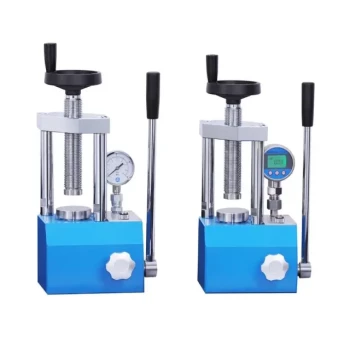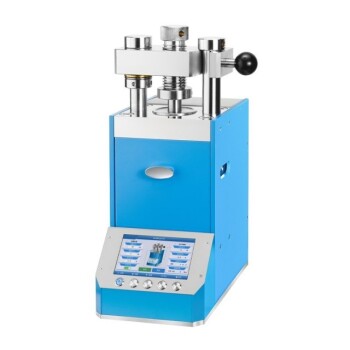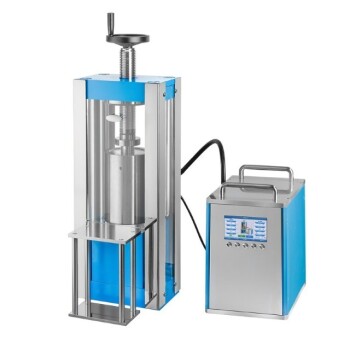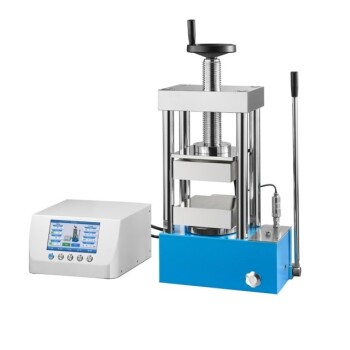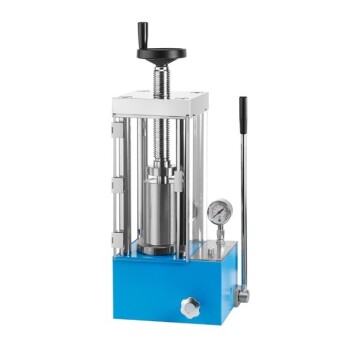At its core, a manual hydraulic press is a hand-operated device designed to apply significant force to a sample using hydraulic principles. It accomplishes this through a lever-operated pump that pressurizes fluid in a cylinder, which in turn drives a piston to compress material. These presses are defined by their simple operation, durable housing, and an integrated pressure gauge for monitoring the applied load.
The central decision in choosing a manual hydraulic press is not about its features, but about a fundamental trade-off. It offers significant cost savings and simplicity in exchange for increased physical labor and less repeatable pressure application compared to its automatic counterparts.
How a Manual Hydraulic Press Works
A manual press operates on the well-established principle of hydraulic force multiplication, allowing an operator to generate immense pressure with minimal equipment.
The Principle of Hydraulic Force
The system consists of a cylinder filled with incompressible hydraulic oil. When an operator pumps the hand lever, it applies a small force to a small piston, which pressurizes the oil. This pressure is transmitted equally throughout the fluid, acting on a much larger piston that applies a multiplied, powerful force to the sample.
The Operator's Role
The operator directly controls the pressure application by pumping the lever. The force and speed of pumping dictate how quickly the target pressure is reached. This direct physical involvement is the defining characteristic of a manual press.
Monitoring and Control
An integrated, analog pressure gauge provides real-time visual feedback on the force being exerted. The operator watches this gauge and stops pumping once the desired pressure for the sample preparation is achieved.
Key Features and Specifications
While simple in design, manual presses come with specific features and performance metrics that determine their suitability for a given task.
Load Capacity
Manual presses are commonly available in maximum load configurations of 15 and 25 tonnes. This force, which can be up to 250 kN, is more than sufficient for most laboratory powder sample preparation tasks.
Pressing Dies and Tooling
These presses utilize interchangeable pressing tools, often called dies, of various diameters (e.g., 15 mm, 32 mm, 40 mm). The choice of die depends on the specific requirements of the analytical technique for which the sample is being prepared.
Safety Mechanisms
A crucial feature is an automatic pressure relief valve. This safety mechanism prevents the operator from exceeding the press's maximum rated load, protecting both the user and the equipment from damage.
Understanding the Trade-offs: Manual vs. Automatic
The primary disadvantage of a manual press is also its key advantage: the operator. The choice between a manual and an automatic press hinges on balancing cost, effort, and the need for precision.
The Advantage of Cost and Simplicity
Manual presses are significantly less expensive to purchase than automatic models. With fewer moving parts and no complex electronics, they are also easier and cheaper to maintain over their lifespan.
The Drawback of Physical Effort
For labs with high sample throughput, the physical act of pumping the lever repeatedly becomes labor-intensive and inefficient. What is manageable for a few samples becomes a significant burden for dozens.
The Challenge of Repeatability
The most critical drawback is the lack of repeatable pressure application. Different operators, or even the same operator on different days, will apply pressure at slightly different rates and may overshoot or undershoot the target. This inconsistency can affect the quality of sensitive analyses like FTIR or XRF, where pellet density is a factor. In contrast, an automatic press delivers a programmed, highly repeatable force every time.
Common Applications in the Laboratory
Manual presses are a staple in many analytical labs, primarily for creating solid pellets from powder samples.
Pelletizing for FTIR Spectroscopy
They are frequently used to press a mixture of potassium bromide (KBr) powder and a sample into a thin, transparent pellet. This allows infrared light to pass through for Fourier-transform infrared (FTIR) analysis.
Sample Prep for XRF Analysis
For X-ray fluorescence (XRF) analysis, a sample must have a smooth, flat, and homogenous surface. A manual press is an effective tool for compacting powdered materials into a dense, solid disc suitable for XRF.
Making the Right Choice for Your Application
Selecting the correct press requires a clear understanding of your lab's priorities and workload.
- If your primary focus is occasional use or budget constraints: A manual press is a cost-effective and reliable choice for labs that only prepare a few samples per day.
- If your primary focus is high throughput or analytical precision: The superior consistency and labor-saving operation of an automatic press is likely a necessary investment.
- If your primary focus is training or educational settings: The simplicity and direct physical feedback of a manual press make it an excellent tool for teaching fundamental principles.
Understanding this balance between cost, labor, and precision is the key to selecting the right tool for your specific goals.
Summary Table:
| Characteristic | Details |
|---|---|
| Operation | Manual, hand-lever pump for hydraulic force |
| Load Capacity | Up to 25 tonnes (250 kN) |
| Key Features | Durable housing, pressure gauge, automatic relief valve |
| Applications | Pelletizing for FTIR, sample prep for XRF |
| Pros | Cost-effective, simple design, easy maintenance |
| Cons | Labor-intensive, less repeatable pressure application |
Need a reliable lab press for your sample preparation? KINTEK specializes in lab press machines, including manual and automatic options, to enhance your laboratory's efficiency and precision. Whether you're working with FTIR, XRF, or other analytical techniques, our solutions deliver consistent results and cost savings. Contact us today to discuss your needs and discover how we can support your lab's success!
Visual Guide

Related Products
- Manual Laboratory Hydraulic Press Lab Pellet Press
- Laboratory Hydraulic Press Lab Pellet Press Button Battery Press
- Automatic Laboratory Hydraulic Press Lab Pellet Press Machine
- Manual Heated Hydraulic Lab Press with Integrated Hot Plates Hydraulic Press Machine
- Automatic Laboratory Hydraulic Press for XRF and KBR Pellet Pressing
People Also Ask
- What are the advantages of using a hydraulic press for pellet production? Achieve Consistent, High-Quality Samples
- What is the primary purpose of a manual lab hydraulic pellet press? Ensure Accurate Sample Prep for XRF and FTIR
- How should a manual hydraulic pellet press be cleaned and maintained? Ensure Accurate Results and Longevity
- How do you operate a manual hydraulic pellet press? Master Precise Sample Preparation for Accurate Analysis
- What feature of the hydraulic portable press helps monitor the pellet-making process? Discover the Key to Precise Sample Preparation






